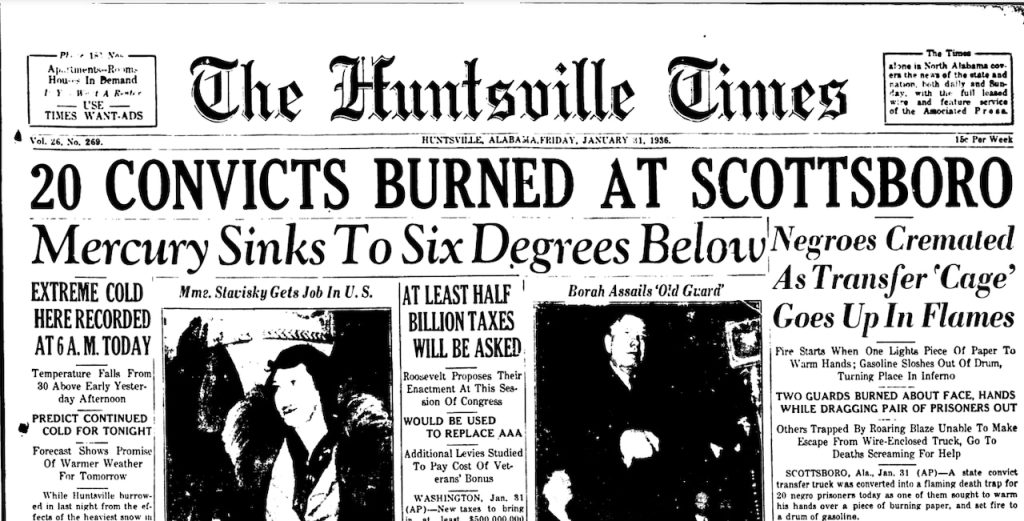This is an opinion column
January 31, 1936 was a brutal day, as ice and “unprecedented” snow swept across North Alabama.
It was six degrees below zero near Scottsboro – a town that had earned global infamy five years earlier with the atrocious treatment of the Scottsboro Boys. It was the kind of cold you rarely feel in Alabama. In your bones, or in the back of a moving truck.
I thought I knew Alabama’s horror stories. I did not know this one.
The Alabama Highway Department on that arctic day asked the prison system – it was referred to as the convict department back then – to use inmate labor to shovel ice and snow on roads and bridges. But when guards prepared to load the men onto trucks at the Scottsboro Prison Camp, they found that almost all the trucks were frozen, inoperable.
It was very cold.
Only one vehicle worked. It was a transfer truck with a bed open to the frigid air, but enclosed with a heavy steel mesh that formed a “cage.” It was of the type usually reserved for dangerous criminals, but the day before it had been used to transfer gas and oil for tractors, and for use in highway flares.
It was, as Gov. Bibb Graves would later acknowledge, against regulations to carry fuel and people in the same vehicle. But desperate times on that Jan. 31 seemed to call for looking the other way.
So inmates began to hop in.
A young man named Paul Dawson climbed aboard. He’d been sentenced to four years in prison for larceny three years before. Back when he was 19.
John Stokes scrambled up, too. He was a little older, in his 30s. He’d served two years on a 10-year sentence for burglary. Twenty other inmates, all of them Black, joined them.
There is much we don’t know about this ill-fated, little-known date in Alabama history. By the only accounts we have – the very limited news of the day – it was a nightmare ride from the start.
It was so cold it would freeze your brain, not just your hands and feet. And workers were in a hurry to get moving, so regulations be damned. They poured 30 gallons of gas in the 50-gallon drum that was already in the truck, and the driver screwed the top of the drum shut. A small, five-gallon can that had been used to carry oil for road flares was left, open, in the bed.
The caged vehicle lurched and skidded in the snow and ice, and gas sloshed across the floor of the truck. Two white highway department workers – H. Middlebrooks and Phil Wasson – sat up front. The Black men in the rear stood, bracing against the arctic cold and holding on for dear life.
It was later, from a hospital, that Dawson told his story of what happened.
He said it was freezing, and an inmate near the front of the truck bed wanted to warm his hands. That inmate, Henry Alexander, pulled a piece of paper from his pocket and set it on fire.
Dawson looked down and saw the river of flame racing across the truck.
“The other boys crowded in the front, away from the gasoline, but Stokes and me clawed at the door,” he said, his words recorded in the Huntsville Times. “Mr. Middlebrook stopped the truck quickly and flung open the door. Me and Stokes jumped out, and they rolled us into the snow, calling for others to jump.”
Maybe the 50-gallon drum exploded. It looked that way, a Jackson County newsman reported. The cage on the truck buckled, at any rate, and gave that appearance. Most of the men in the back of the truck were incinerated.
Dawson and Stokes would be the only survivors from the back of that truck.
Middlebrooks and Wasson suffered burns on their faces and hands, and were initially lauded as heroes. They were later suspended, along with a supervisor, as the governor ordered Jackson County authorities to begin an investigation “to determine if there was any criminal negligence.”
In the face of it all, the weather and the gasoline, the breach of regulations and the casual inhumanity of it all, everybody from the Huntsville Times to the governor blamed the inmates for the deaths.
“A Negro struck a match,” a state engineer said, as if with a shrug.
The news of the day spoke of dead men in the way it often spoke of Black people. In the way it often spoke of inmates. As if they were less than human, like Alabama still talks of people in its horrifying prisons.
The Times wrote of traffic problems the “cremation” caused:
“Traffic on the highway piled up for a mile or more on either side, as scores of curious spectators gathered about the blackened frame of the death trap containing its grisly cargo of 20 fire-charred bodies.”
The story of these men got global attention for a few days, mostly because the name Scottsboro grabbed eyeballs.
The Times seemed to seek humor in the tragedy. It cost a London newspaper $33 to call a local sheriff to ask if Scottboro Boys were among the dead.
“No,” the sheriff told the Daily Mail. “You are mixed up. The Negroes burned were state prisoners, and the only connection Scottsboro had with it was the accident happened near there.”
“The receiver clicked,” the Times concluded.
Within three weeks the state had settled with the families of the dead for a grand total of $23,200 – about half a million dollars in today’s money. Two families got $1,500. The rest got $1,000 (more than $22,000 today). And the story simply disappeared.
What happened to Dawson and Stokes remains, for now, a mystery. What happened with the investigation is also elusive.
There are many stories out there, forgotten, suppressed, ignored, that tell us how we came to this time we call our own. They are stories we need to know. Especially as we look today at our own deadly prisons, at race and equality and the way we treat each other.
They are important. Not just to help us know who we are, but to help us decide who we want to be.











